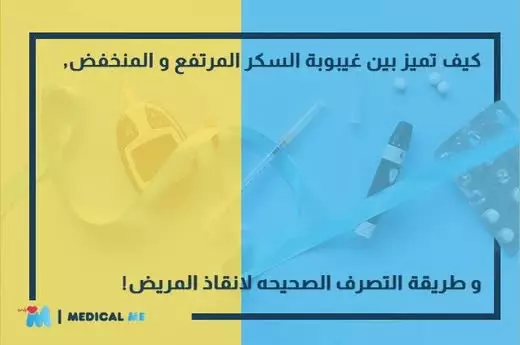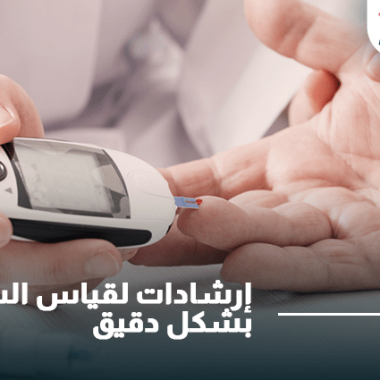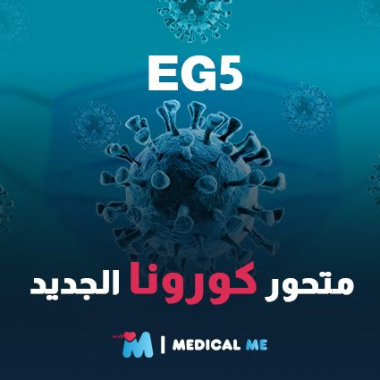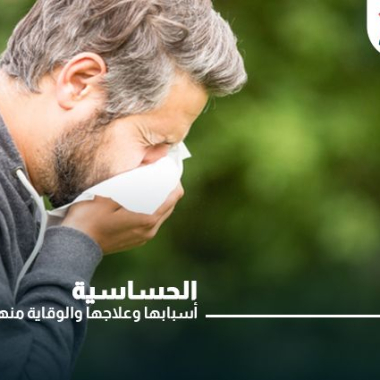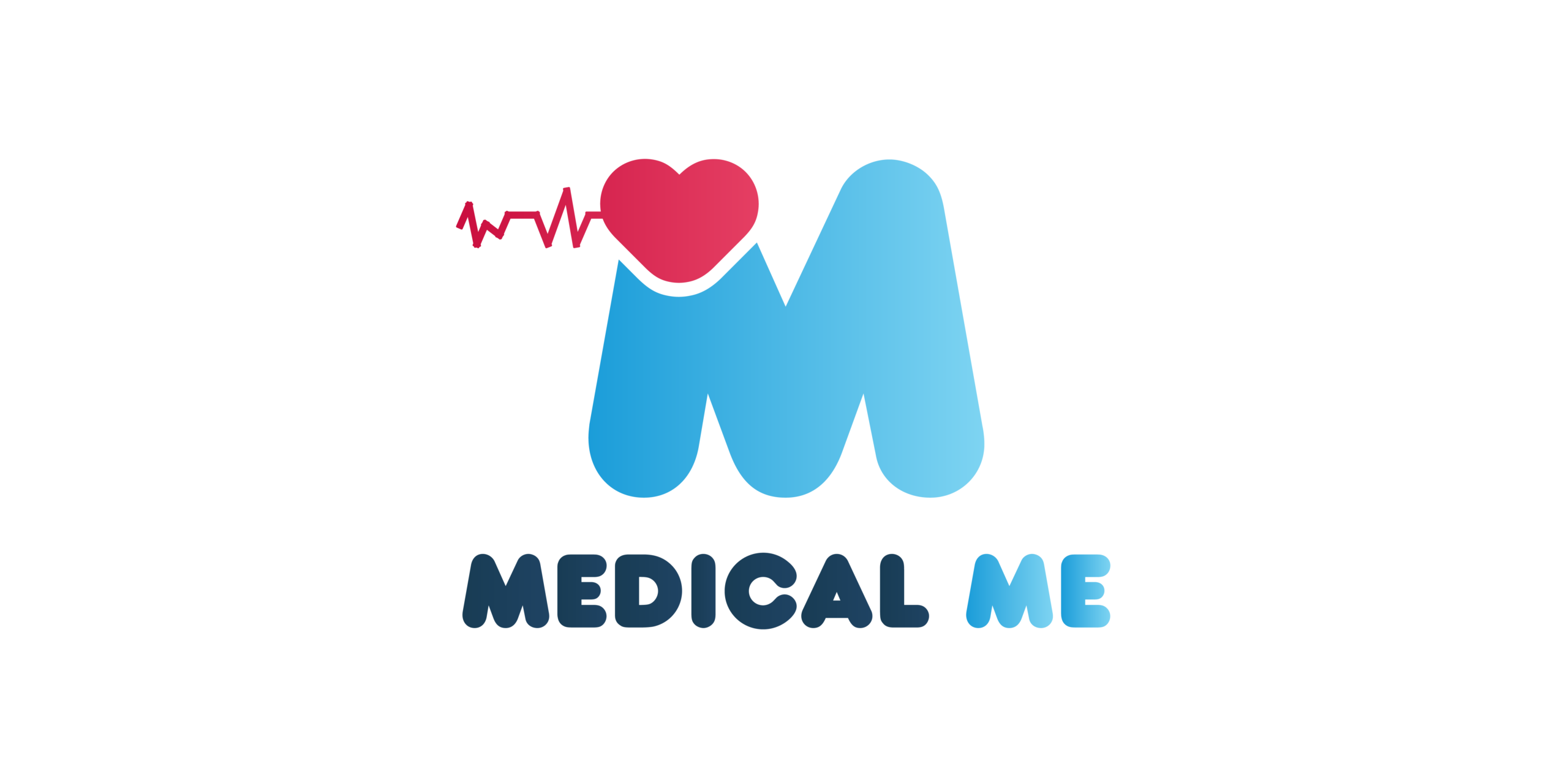Hypoglycemic and Diabetic Coma
How to save a patient suffers from hyperglycemic and hypoglycemic diabetic coma
Diabetic coma is one of the most important complications of diabetes that can be life-threatening and cause death in the absence of proper first aid; This makes knowing the basics of dealing with a diabetic coma one of the priorities that may help you save the lives of those who are affected.

If you notice the patient losing consciousness, you must first differentiate between a diabetic coma and death, and then differentiate between a high blood sugar coma (hyperglycemia) and a low blood sugar coma (hypoglycemia), and then start taking correct medical measures.
The difference between a diabetic coma and death:
There are some signs that help you determine if a person is dead or fainting:
- The absence of any movement in the body with complete apnea.
- The pulse has stopped, and you can determine this by the artery in the neck or hands.
- If you examine the eye, you will notice that the pupils of the eyes are dilated and do not respond to the light of the searchlight.
- The heartbeat stops, and you can check this by placing your hands on the heart and trying to feel or hear those beats.
As for signs of loss of consciousness in that case:
- The patient is breathing normally.
- We notice that his pulse is clear and palpable.
- The patient’s heartbeat can be felt.
Causes of a diabetic coma:
Diabetic coma is one of the complications of diabetes that a large number of diabetics face, especially when the blood sugar level is too high or too low.
Causes of high blood sugar (Hyperglycemia):
A high blood sugar level of more than 600 mg/dL, this condition is called diabetic hyperosmolar syndrome, and it can result from this condition as a result of:-
1- Not committing to eating healthy meals and foods on time and resorting to eating large amounts of sugar in a small period that can cause a high sugar coma.
2- Taking types of illegal drugs such as: cocaine causes high blood sugar levels that can lead to a diabetic coma.
3- Not monitoring your blood sugar periodically using home glucose meters makes you more vulnerable to high blood sugar and loss of consciousness as a result of exposure to a diabetic coma.
4- No taking the insulin dose on time.
Low sugar coma causes:
The blood sugar level is less than 70 mg/dL and this condition is caused by:
1- Taking an overdose of insulin or not meeting the prescribed dates for taking the dose.
2- Stop eating for a long time; This causes a severe drop in blood sugar.
3- The desire to get rid of excess weight improperly by following a wrong diet that is not under the supervision of a doctor.
4 – Exercising hard or exercising intensely is the most important reason; Because it causes a severe drop in blood sugar and thus hypoglycemic coma.
5-Alcohol causes hypoglycemia and may lead to a diabetic coma.
Diabetic ketoacidosis coma:
This condition is more common in patients with type 1 diabetes, but this does not prevent the possibility of patients with type 2 diabetes, and gestational diabetes from being exposed to this condition, so caution must be taken.
What happens in diabetic ketoacidosis?
Muscles need to produce energy, so they resort to breaking down stored fat cells. The breakdown of these cells results in toxic acid production called ketones. With high blood sugar, diabetic ketoacidosis occurs; If this case is untreated, this may cause diabetic coma.
Symptoms of a diabetic coma:
It is necessary to know the difference between high and low sugar coma, because distinguishing between them will help you take many correct actions that could help you save the patient’s life who may be a member of your family and you care about.
Symptoms of a hyperglycemic coma:
1- Slow loss of consciousness.
2- Dry skin, mouth and lips.
3- The smell of the mouth is similar to fruit smell or acetone.
4- The pulse is fast and weak.
5- Stomach pain, feeling nauseous and wanting to vomit before losing consciousness.
Symptoms of a low sugar coma:
1- Rapid loss of consciousness.
2- Moisture of the skin and mouth.
3- Natural mouth odor.
4- Profuse sweating and weak pulse.
5- A tremor in the hands.
6- Confusion and difficulty speaking before losing consciousness.
The duration of a diabetic coma:
The duration of a diabetic coma varies from one person to another, and it also varies according to the situation and whether it is a hyperglycemic coma or a hypoglycemic coma. Measuring the level of sugar in the blood contributes to reducing that period and protecting the patient from the complications of that coma and its impact on the brain.
Diabetic coma during sleep:
If you notice in a diabetic patient symptoms of low blood sugar and feel a severe drop that leads to his desire to go to sleep, thinking that he will wake up in a better condition, then this condition is one of the most dangerous cases that expose the patient to a low diabetic coma during sleep. This threatens his life, as those around him think that he is asleep and does not suffer from a coma, and this leads to death because the patient is not treated.
We note that the symptoms of hypoglycemia go through three stages:
First stage:
The patient can save himself if he feels a rapid heartbeat with a tremor in the body and sweating, in this case the diabetic patient can take a spoon of honey with measuring the blood sugar level after half an hour and take another spoon if the percentage does not reach its normal rate.
Second stage:
In which the patient feels dizziness, delirium and imbalance as a result of the lack of sugar in the brain, and he can request measuring the sugar percentage from those around him and bring a glass of water with sugar or honey.
Third stage:
The patient loses consciousness after experiencing convulsions. In this case, the patient can be helped by placing honey on the lips, the inner part of the mouth and under the tongue, as honey is easily absorbed and reaches the blood.
We conclude from this that if the patient feels symptoms of a hypoglycemic coma, he should not go to sleep before performing the necessary first aid to raise the blood sugar level. It is considered low, but if the percentage is less than 45, this condition is considered serious and you must act quickly and seek help.
First aid in a hyperglycemic coma:
1- Firstly, Ask for emergency help.
2- Then, measure blood glucose level using home glucose meters. If the sugar level exceeds 600, this condition is considered a high sugar coma.
3- It is forbidden to give the patient any kind of sugar or sweets.
4- Give the diabetic coma patient a dose of insulin.
5- If you can give the patient intravenous fluids, do not hesitate to inject him with an intravenous solution of potassium and sodium.
First aid in a hypoglycemic coma:
The most dangerous coma is hypoglycemia, and it occurs due to hypoglycemia or low glucose, but what is the correct behavior for diabetics in this case:
1- Seek emergency or medical help immediately.
2- Make the patient lie on the ground with his head raised as high as possible.
3- Usually the patient has some awareness and can be given juice or water with sugar or a spoon of honey, but if the patient is in a deep coma, it is forbidden to give him any liquids so as not to cause him to suffocate during breathing.
4- Placing honey on the lips and mouth from the inside and under the tongue, as it is easily absorbed and goes into the blood of the case quickly. 5- Injecting glucagon or giving the patient dextrose intravenously.
6- It is forbidden to give insulin in this case.
Conclusion:
In this article, we talked about two types of diabetic coma that occur as a result of high or low sugar levels, including high and low sugar coma and diabetic ketoacidosis, in addition to the symptoms that appear on patients of each type and how to distinguish between them, and what are the causes of each case. Methods of treatment, quick handling and first aid necessary for proper handling and saving those exposed to an emergency or life-threatening situation.
